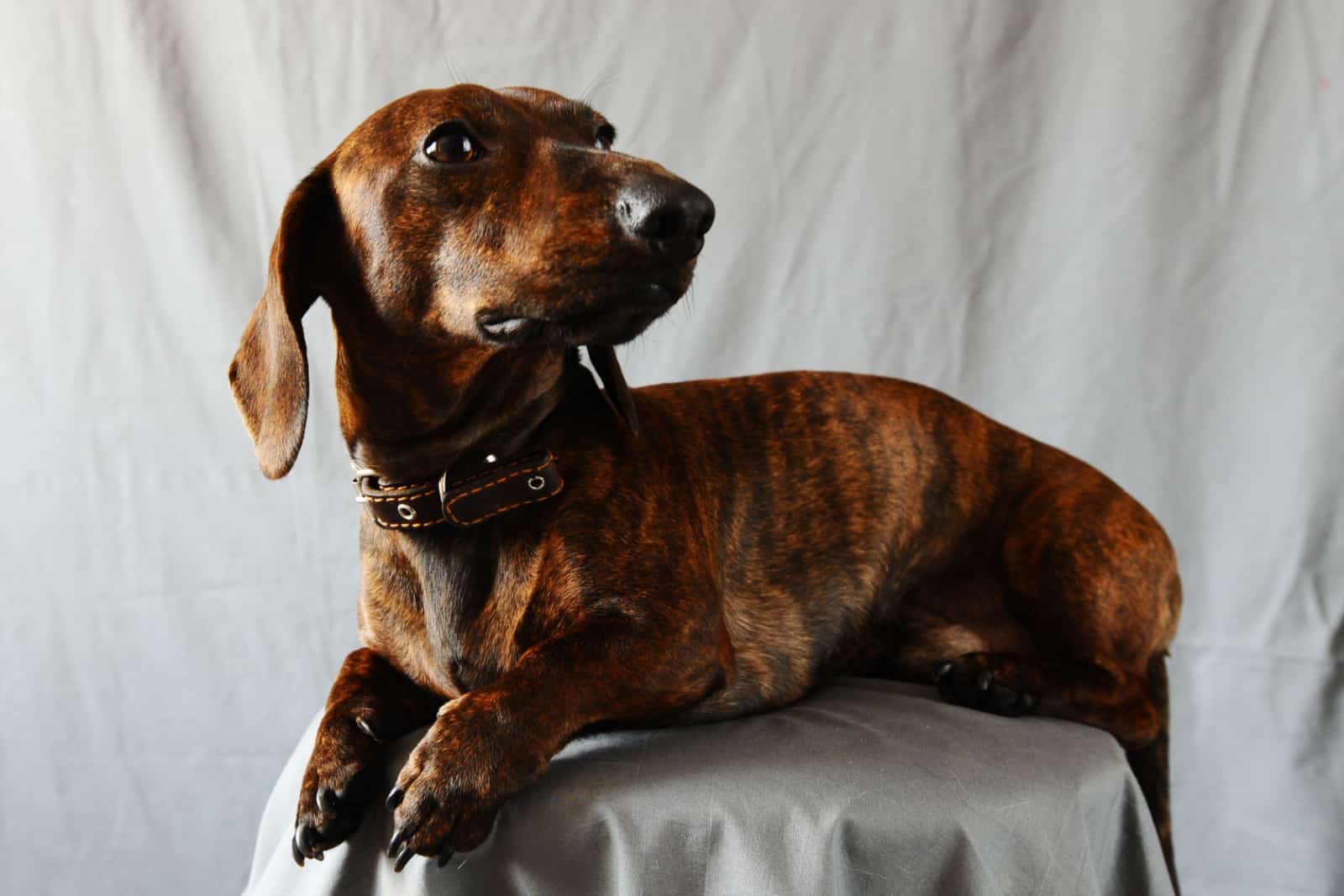The Dachshund is a lovable and friendly dog breed, beloved by all for their iconic look and overall utility, but what makes the brindle Dachshund so special?
Well, the brindle Dachshund isn’t just yet another color variation of the ever-loved sausage dog, but a potential coat pattern that appears like a set of dark tiger stripes over his fur.
It’s not exclusive to any one color and can appear on a variety of them which makes it appealing to a lot of potential pet owners and gives incentive for breeders to try and reproduce the result and sell the Doxie puppies at a higher price.
Plus, it doesn’t disqualify the pups from any AKC (American Kennel Club) approved dog shows either as it’s not considered a different color, but rather a pattern that can appear on any coat color.
The problem lies in its relative rarity. Though not as uncommon as some, in order to get a brindle Dachshund, the dominant gene in one of the parents must be the brindle gene, and it must carry over as such.
While it’s not particularly noticeable in some cases, the pattern still provides ‘shading’, for lack of a better term, giving your dog’s appearance a slightly darker fur texture which can be appealing to some.
Read on to find out what are all the possible colors that brindle Dachshunds can be, which of said colors are standard for the dog and can be used in conformation shows, as well as a bit more about the breed and the answers to the many questions people often ask about it.
The Dachshund: Breed History
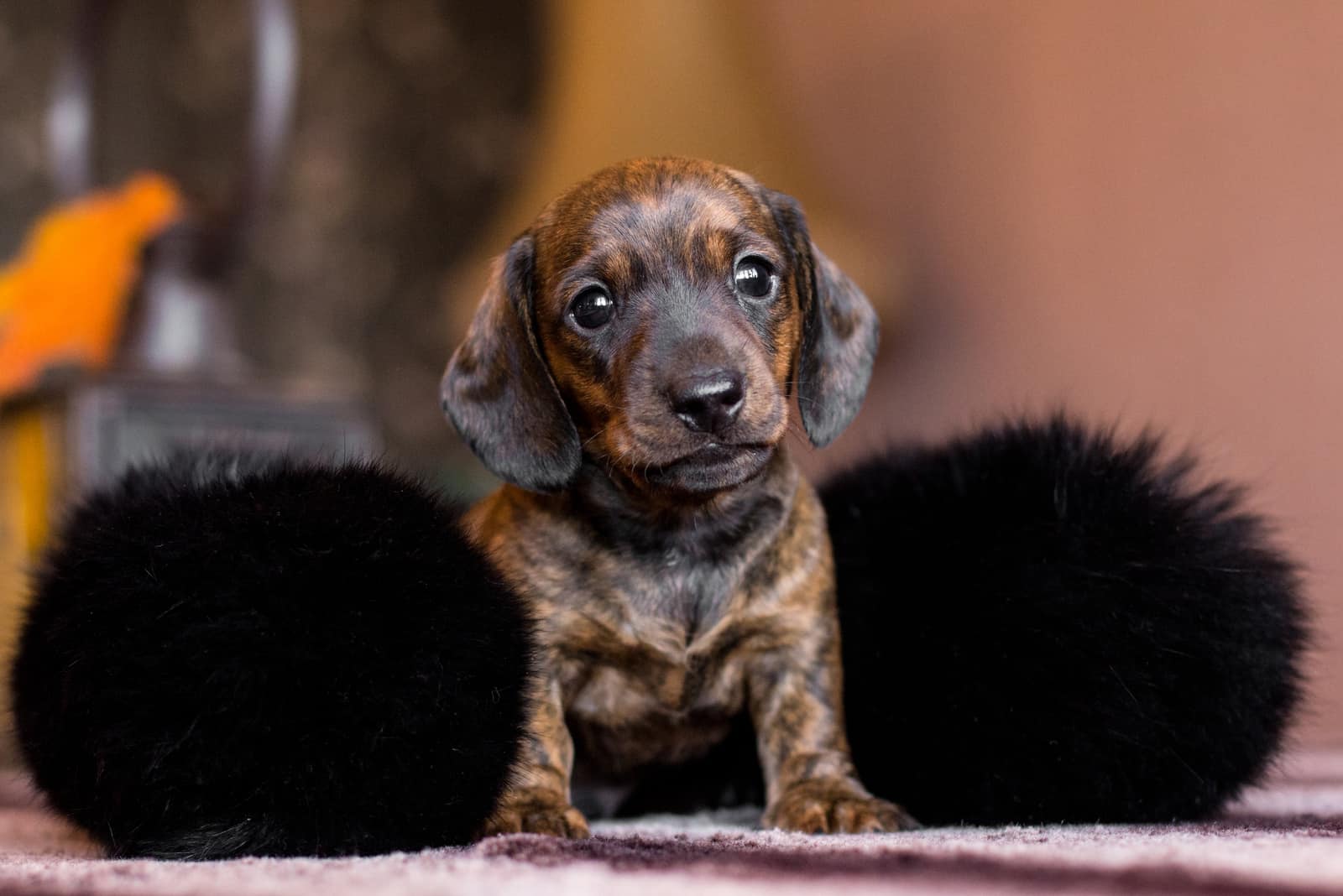
Before we get into the brindle Dachshund, we have to understand where this great dog’s roots came from.
For one, it’s one of Germany’s greatest treasures despite not being their national dog.
Initially he was called the Dachs Krieger, or ‘badger warrior’ when translated from German and was bred by German breeders way back at the start of the 18th century.
Though some records show their origins to potentially date all the way down to the 15th century.
Teckel was another common name for its prior incarnation.
Though, this wondrous dog breed wasn’t made with only German breeds, but has taken from a variety of different terriers and hunting dogs from prevalent countries at that age like Britain and France.
His purpose was to be a hunting dog who’d help hunt smaller game that could burrow or hide in smaller places where the bigger dogs couldn’t go into, hence the name.
His entire body was specifically bred for this very purpose, which is why his shape gave him the iconic ‘sausage dog’ title, it made him be more mobile and limber when crawling through such spaces.
Their sense of smell too, was, and still is, exceptional, being able to track scents that are up to 7 days old in some of the best examples.
The first iteration of these dogs was bigger than the modern variant, coming in at around 30 to 40 pounds on average as opposed to the 15 to 30 pound average we have today.
The size came in handy when they were used to hunt bigger game, though their primary role still remained in drawing smaller game out like foxes, badgers and rabbits.
As for when the breed came to our shores, the Dachshund was initially introduced to the US near the end of the 19th century, somewhere around the year 1880, in the form of the double dapple Dachshund.
They weren’t exactly the best representatives though as they were marred with a number of potential health risks, most revolving around their eyesight.
However, the smooth haired Dachshund is believed to be the original from which the modern versions of the wire haired Dachshund and the long haired Dachshund originated from.
The breed was recognized by the AKC relatively quickly after its introduction, in the year 1885.
There’s a bit more history here between the lines, but, at present, it’s all currently a mess with conflicting information and several theories about the breed’s origins and its variants.
The Brindle Dachshund And The 2 Other Common Variants
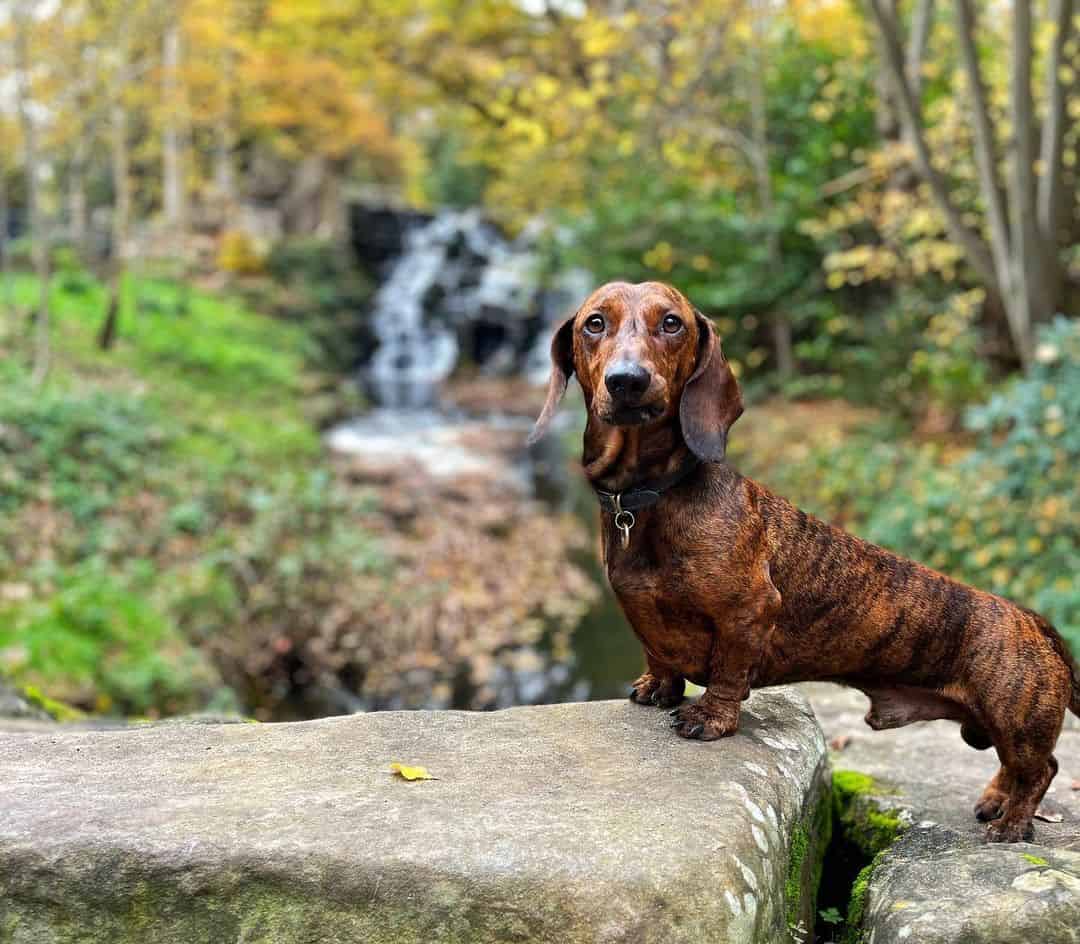
With its history out of the way, it’s time to take a look at the actual brindle Dachshund and its many variants, be it in patterns or colors.
The brindle is one of many possible pattern options with dapple and piebald Dachshunds being the other two more common ones.
The brindle, as stated earlier, is a variant where the pattern appears striped and is often tinted a darker color, providing some tone to the existing fur color with said coat pattern.
Dapple Dachshunds on the other hand have a more spotted pattern with random dark dots littered over their coats, as the very name suggests.
This one may look a bit more chaotic than the brindle variant does, but there’s some odd appeal in all that chaos.
The piebald Dachshund variant is arguably the most drastic one of the bunch in terms of visibility.
It includes a set of darker colored patches of varying colors appearing on the back, neck and parts of the head or muzzle set against a predominantly white coat color.
It’s the pattern variant that we see most stereotypical farm dogs have, and, because of that, has this weirdly comfy and homely appeal to it.
The Possible Colors Of The Brindle Dachshund And Other Variants
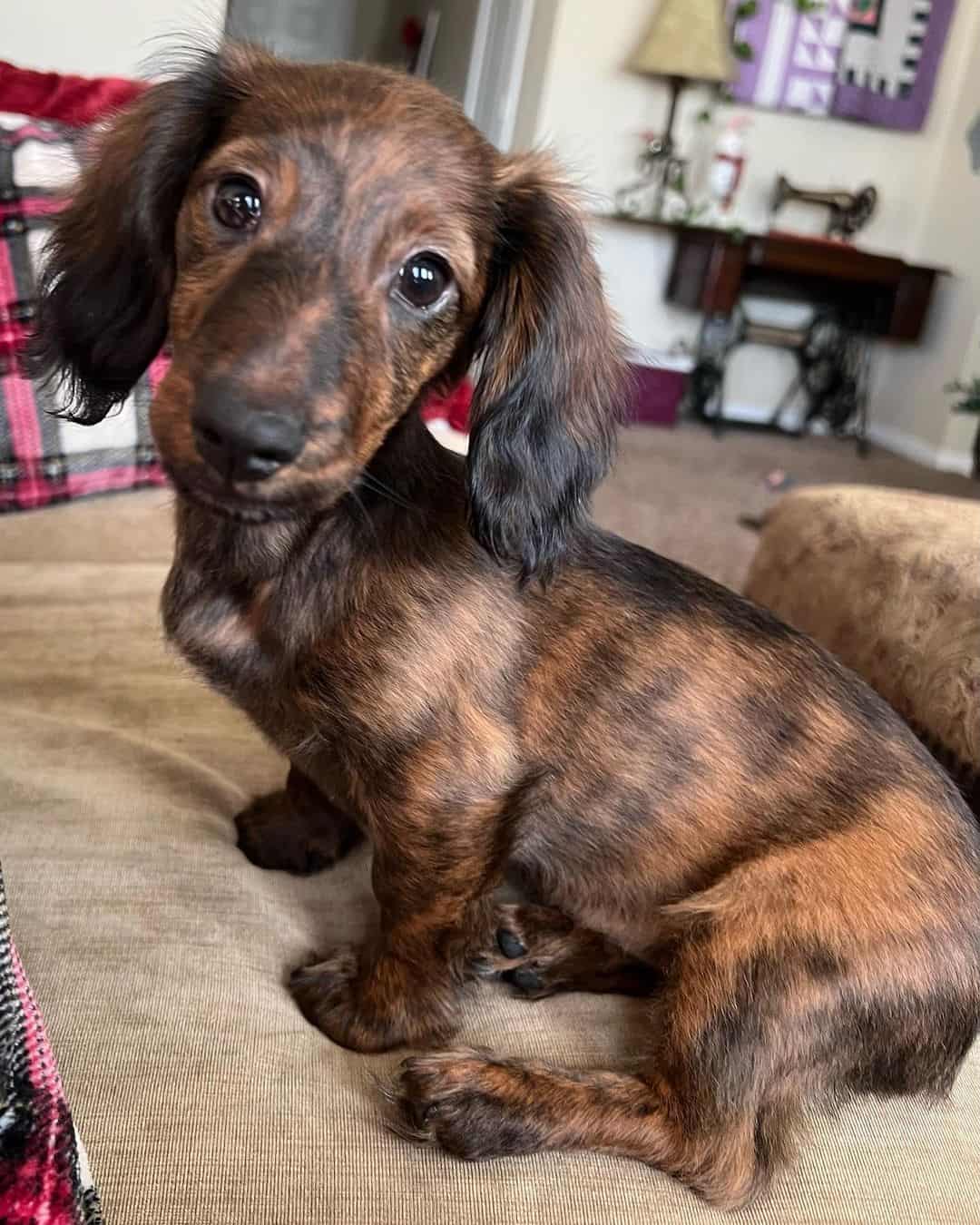
The patterns aren’t exclusive to a singular color either, but can appear on a variety of different ones.
Though, the problem arises in trying to figure out which colors are standard and which ones aren’t, according to the AKC at least.
Here’s a list of all the standard AKC colors first and foremost:
- Black and Cream Dachshunds
- Black and Tan Dachshunds
- Blue and Tan Dachshunds
- Chocolate and Tan Dachshunds
- Cream Dachshunds
- Red Dachshunds
- Wheaten Dachshunds
- Wild Boar Dachshunds
- Blue and Cream Dachshunds
- Fawn (Isabella) and Tan Dachshunds
- Fawn (Isabella) and Cream
- Chocolate and Cream
Do keep in mind that not all of these have brindle variants that are that common at the very least, here are the ones that do:
Fawn And Tan Brindle Dachshunds
Shockingly enough, the fawn Dachshund isn’t a standard color according to the American Kennel Club’s classification, but the fawn and tan one is, and it does have a brindle variant.
The ‘fawn’ color symbolizes all the colors one can find on a fawn, anything from softer, lighter browns, to darker browns.
That’s then paired up together with various tan spots and finalized with the striped brindle pattern.
The prevalence of any of these extra markings varies based on parentage
Red Brindle Dachshunds
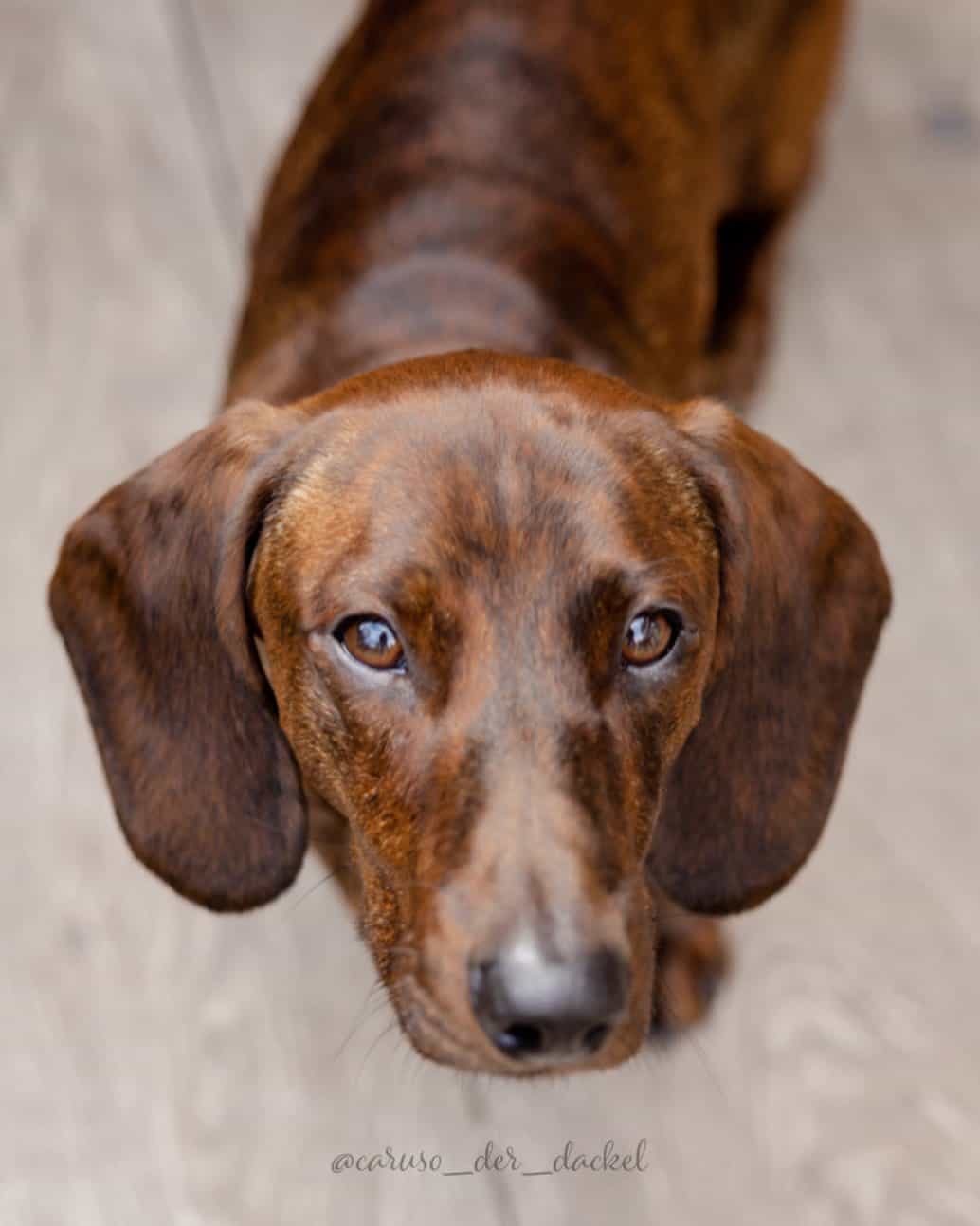
Another lovely variant, and one that most commonly ends up developing a brindle pattern.
The coat isn’t really red, but a sort of reddish brown with varying intensity and paired together with the darker black stripes.
The brindle pattern can also come up as brownish in this particular case, depending on how strong the gene for the red color is in the first place.
They’re also one of the more commonly seen Dachshunds in the first place.
Apart from the brindle pattern, the edges of their ears and paws can have a darker hue to them, but that part is a potential extra with the red Dachshund in general.
Black And Tan Brindle Dachshunds
Yet another surprise, the black Dachshund itself isn’t considered to be a standard color, yet the black and tan variation is.
Next to the red one, it’s definitely the most stereotypical Dachshund coat coloration with primarily black fur with tan brown markings on the muzzle, parts of the brow, the chest, and the paws, like a mini Rottweiler.
The brindle coat pattern itself is incredibly hard to discern as it more or less blends into the black fur, so the biggest differences that you’re going to spot are going to be around his paws and other tan brown areas where he’ll have the darker stripes.
It does give the dog an interesting texture, but it’s certainly not the biggest change as it is for a lot of the other variants on this list.
Black And Cream Brindle Dachshunds
Another black variant, one that’s similar to the black and tan except the tan patterns are replaced with a softer and lighter cream color.
The brindle patterns on this one are a lot easier to notice on the cream parts as they’re going to stand out more, giving off a nice mix of light and dark, as if looking at furry marble.
Chocolate And Tan Brindle Dachshunds
Lo and behold, another case where the singular color, chocolate in this case, is considered to be the more unusual coloring than the mix of chocolate and tan.
Thankfully, that doesn’t particularly ruin anything in the dog, unless you wanted to run your chocolate Doxie in a dog show.
The colors here are a mix of very dark brown and a lighter shade where the patterns can be found on similar variants, the muzzle, parts of the brow, the chest, belly and the paws.
The brindle part here, however, is very hard to notice as, unlike in many others, it’s not particularly black, but rather a darker brown which can get lost in the fur, especially if he’s a long haired Dachshund.
Thankfully, their particular coloration isn’t all too rare and, thus, doesn’t suffer from being more prone to various health issues like some other color combinations would.
Cream Brindle Dachshunds
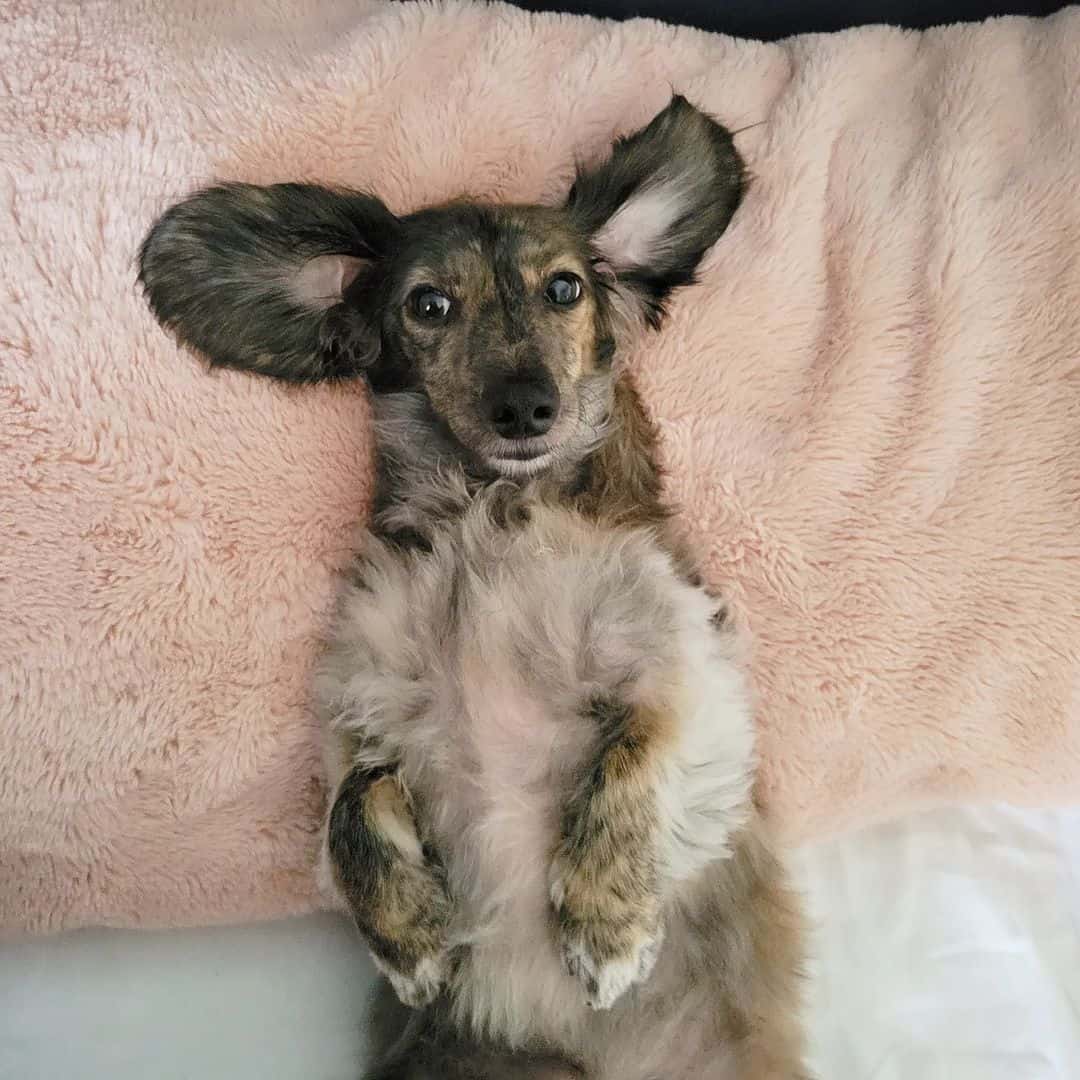
Finally, we have the cream brindle variant, one that’s quite uncommon for the Dachshund, arguably one of the rarer standard ones.
They appear like little golden retrievers, usually with longer hair, though there are short haired Dachshund variants too, with a lighter, creamy color to them paired together with darker stripes as if decorating the foam on a latte.
What Are The Non-Standard Colors Then?
While the other standard colors can potentially have brindle patterns they’re quite rare and they aren’t worth mentioning. Plus, they’re relatively similar to what’s on offer already.
With that in mind, there are still some non-standard colors to look into as well, ones that the American Kennel Club doesn’t recognize, but that still exist and are equally loved by Doxie owners everywhere.
Here are some of the most popular non-standard ones:
- Blue Dachshunds
- Fawn Dachshunds
- Black Dachshunds
- Chocolate Dachshunds
There are a few more, but they don’t really have brindle variants, or the variant is too rare to have a consistent line of brindle pattern Dachshunds-
Blue Brindle Dachshunds
If there’s a particular type of brindle Doxie that’s my favorite, it has to be the blue Brindle Dachshund puppy. The ghostly pale coloration of his fur paired with the darker brindle stripes gives it an incredibly beautiful aesthetic.
The variant is pretty rare though as it’s a recessive gene and both of the dog’s parents would need to have it to even have a chance of one of the pups having it.
For things like these, it’s normally a 1 in 4 type of deal, but it can vary.
Black Brindle Dachshunds
One of the many mentioned earlier that oddly aren’t considered standard when most single colored coats usually are.
Regardless, its rarity is the reason for this as a recessive gene is responsible for getting a black Dachshund with none of the usual markings.
The brindle pattern, given how it’s non standard, doesn’t apply in that regard. It comes in its usual striped form, albeit in a dark brown rather than a purely black one, and it’s pretty hard to notice, just like on the black parts of the black and tan variant.
Chocolate Brindle Dachshunds
A nice and even dark brown color coat for this little guy, one that is then decorated with the nice, tan stripes.
They’re relatively difficult to notice if the intensity of his fur color is too high, but it’s definitely there and provides that light contrast around the affected area.
Fawn Brindle Dachshunds
Finally, we have the fawn Dachshund, one that can achieve similar colors to that of the chocolate, but its lower end is much lighter than the chocolate one’s, meaning he can appear in lighter browns too.
The brindle stripes are particularly easy to notice on this non-standard Dachshund too when their fur is lighter, adding those dark hues to his otherwise impeccable fur.
There’s also a brindle piebald Dachshund variant of the fawn coat which is more or less the same aside from the odd white areas on the usual places where piebald can strike, the paws, the muzzle, the chest, face and even the back.
How Do You Get A Brindle Dachshund?
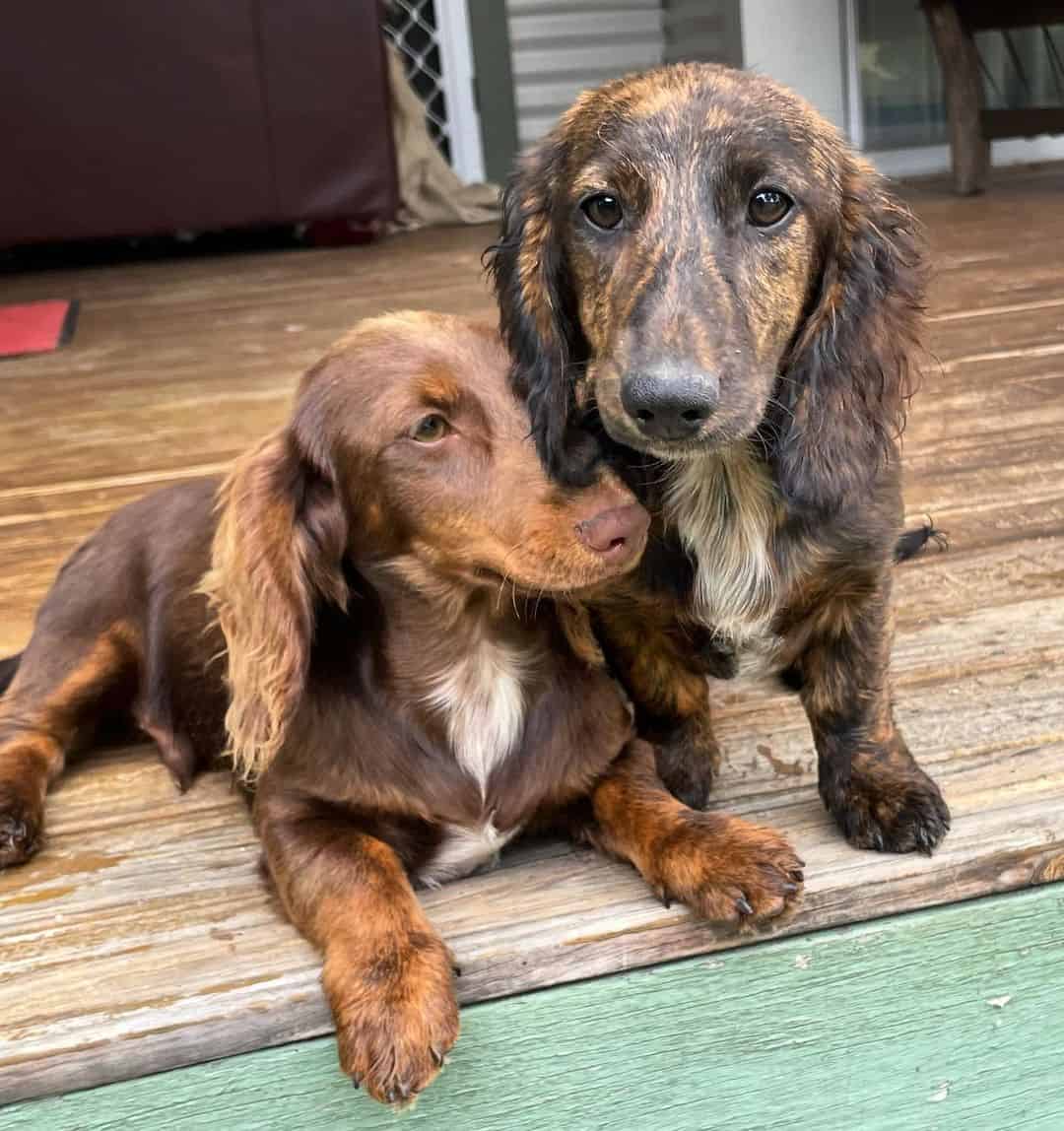
Well, it’s all a matter of genes and describing it is a complicated process, but the main gene that causes the brindle pattern to appear in the first place is the (A) gene, otherwise known as the Agouti Locus.
Said gene can either be dominant (A/A) or recessive (a/a). The former gives a pure black coat while the recessive one is going to only have a few areas appearing as black, which manifests in the stripes we’ve dubbed as the brindle pattern.
Though, it also depends on how said pigment is distributed, which then controls how strong of a presence the brindle stripes have on the fur.
That said, unlike some of the non-standard Doxie colors, this one doesn’t need both parents to have it to manifest which makes the pattern more prevalent than some colors, and makes the mix with said colors incredibly rare.
Are Brindle Dachshunds Hard To Come By?
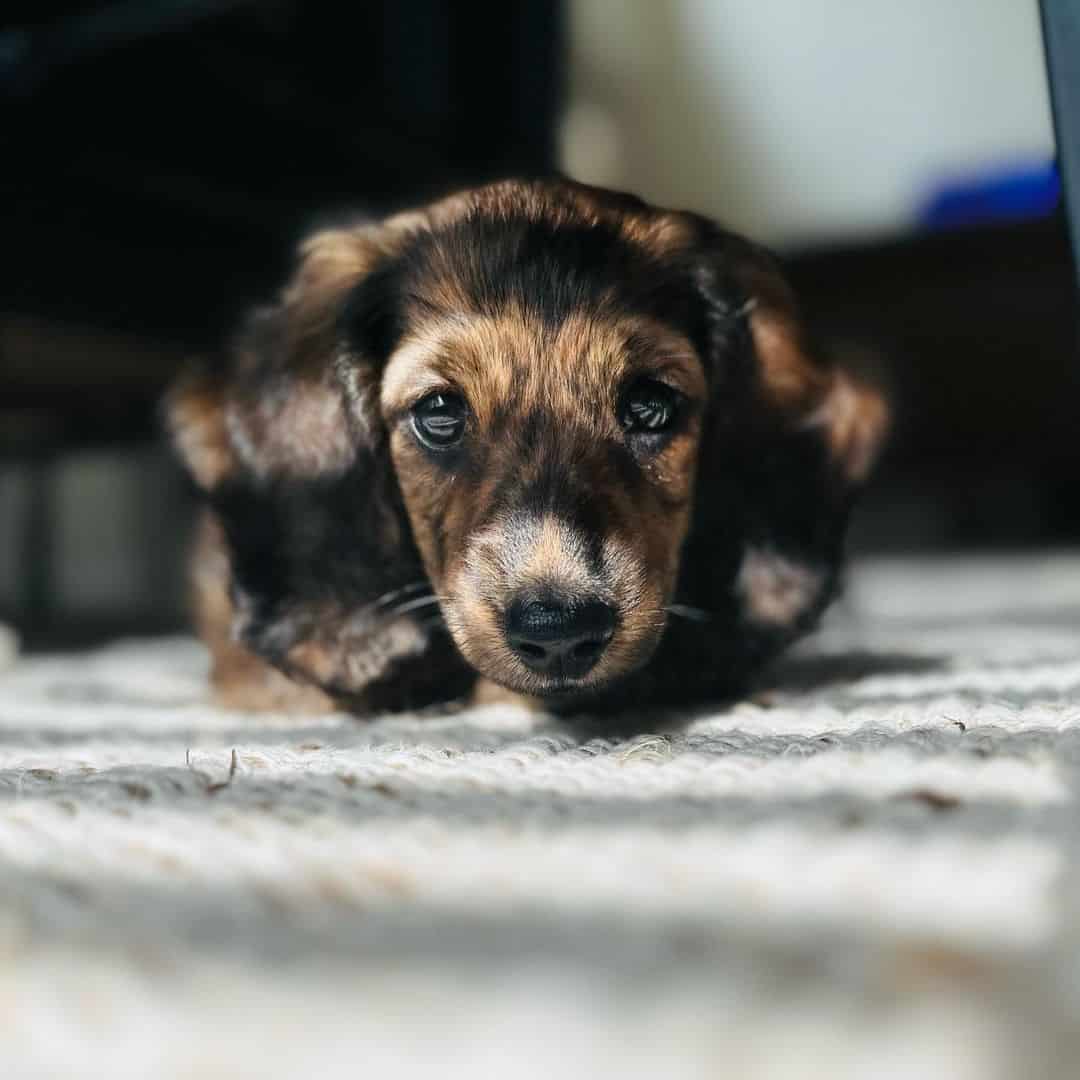
Not particularly. Despite the whole gene speech earlier, it’s a lot less complicated in practice than it seems given the gene’s incomplete dominance.
As said earlier, all you really need is one of the parents to have the brindle gene to have a chance of producing a pup or two in the next litter with the pattern in question.
This way, you can do targeted breeding a lot easier than you would by trying to breed a blue Doxie for example.
What’s The rarest Dachshund Color?
While not directly pertaining to the brindle aspect here, the rarest color one can find a Dachshund being is fully black.
That rarity is the main reason why a black dachshund isn’t considered to be a breed standard as only a handful of them ever appear with this singular pigment.
Can The Brindle Dachshund Come Combined With Another Coat Pattern?
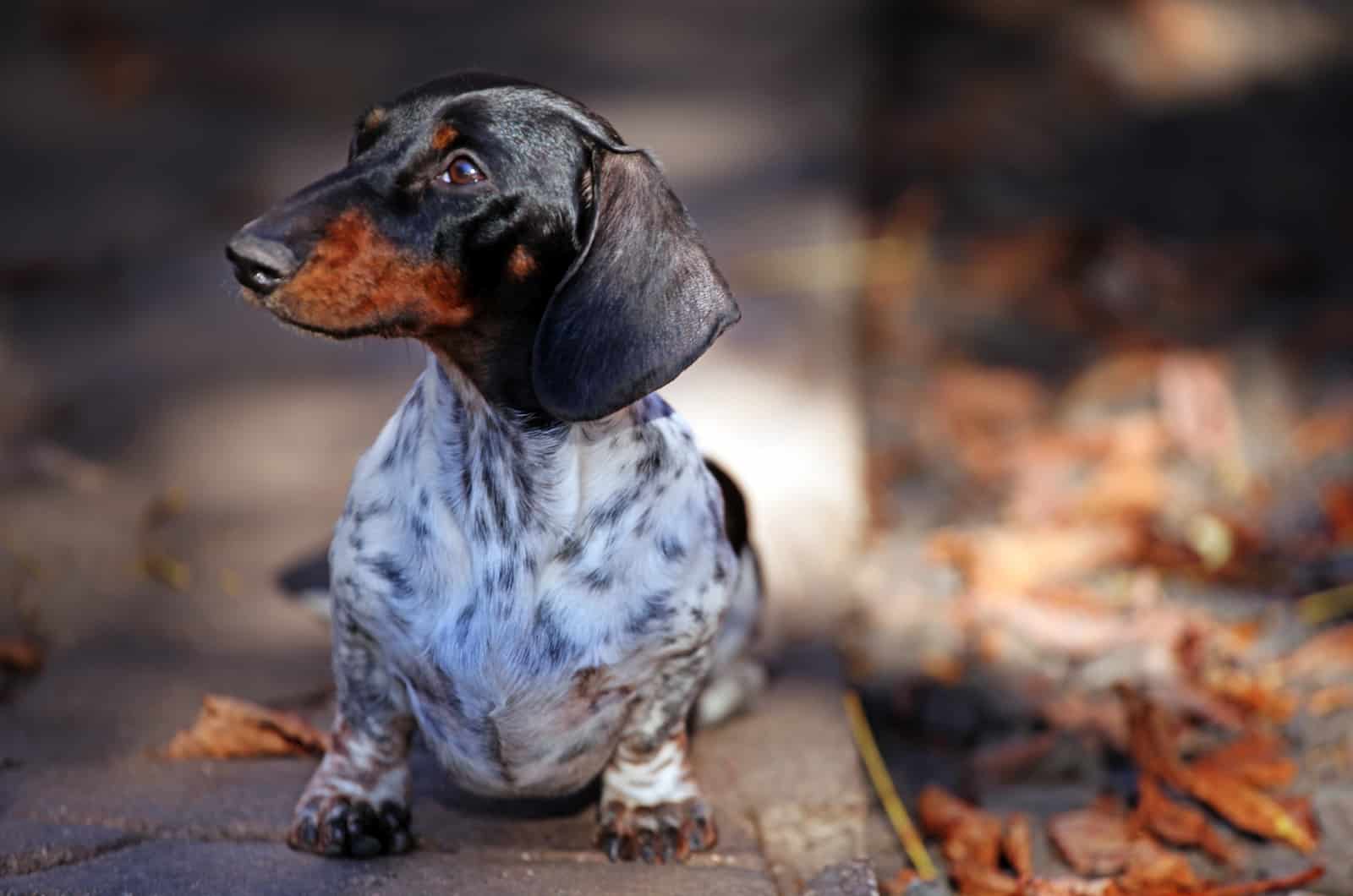
It most certainly can. There are plenty of examples of both brindle piebald Dachshunds and brindle dappled ones.
The former sports a few extra patches of yet another color over the dog’s base coat colors and the stripes thanks to the merle gene, making him look like a Jackson Pollock painting, a beautiful mess.
They appear in the usual places where the piebald pattern does, the chest, back, head, throat, or paws.
The latter, on the other hand, adds smaller spots and spotted patterns over the dog, similar, but slightly different, especially as to where it occurs, usually resembling white markings when it does occur.
What’s The Average Cost Of A Regular Dachshund?
The average cost of regular Dachshunds goes anywhere between $500 to $4000 depending on the coat color, health and accolades of the parent dog in question.
Show dogs and rarer coat colors tend to fetch higher prices, but a bog standard, non show dog Doxie will run you around $1500 on average.
But, as I say with every breed, this is just the purchase price, owning a dog requires a lot more monetary investment on top of the time, effort and love that you’re already putting into your new furry friend.
There are plenty of small costs that rack up when their numbers are added like dog beds, collars, leashes, medical treatments, toys, and dog food in particular are the biggest culprits, especially if you want him to be on a healthy diet.
What About The Cost Of A Brindle Dachshund?
The costs of a brindle Dachshund are somewhere in that large cost frame, floating around $1000 to $2500, again, depending on the rarity of the base coat color.
The extra costs still apply, so do take them into account as well.
Is It Worth The Price?
In this case, kind of. It’s not that much different than a regular Doxie and if you like the color enough to want to give a few hundred bucks extra, then I say go for it.
The difference here is that a good number of the standard choices at the very least aren’t detrimental to your dog’s health to a significant enough point so you’re not sacrificing his well being for aesthetics.
With some other dogs like pugs, bulldogs and similar, that’d be a whole different story, but for a Dachshund, it’s perfectly fine.
FAQs
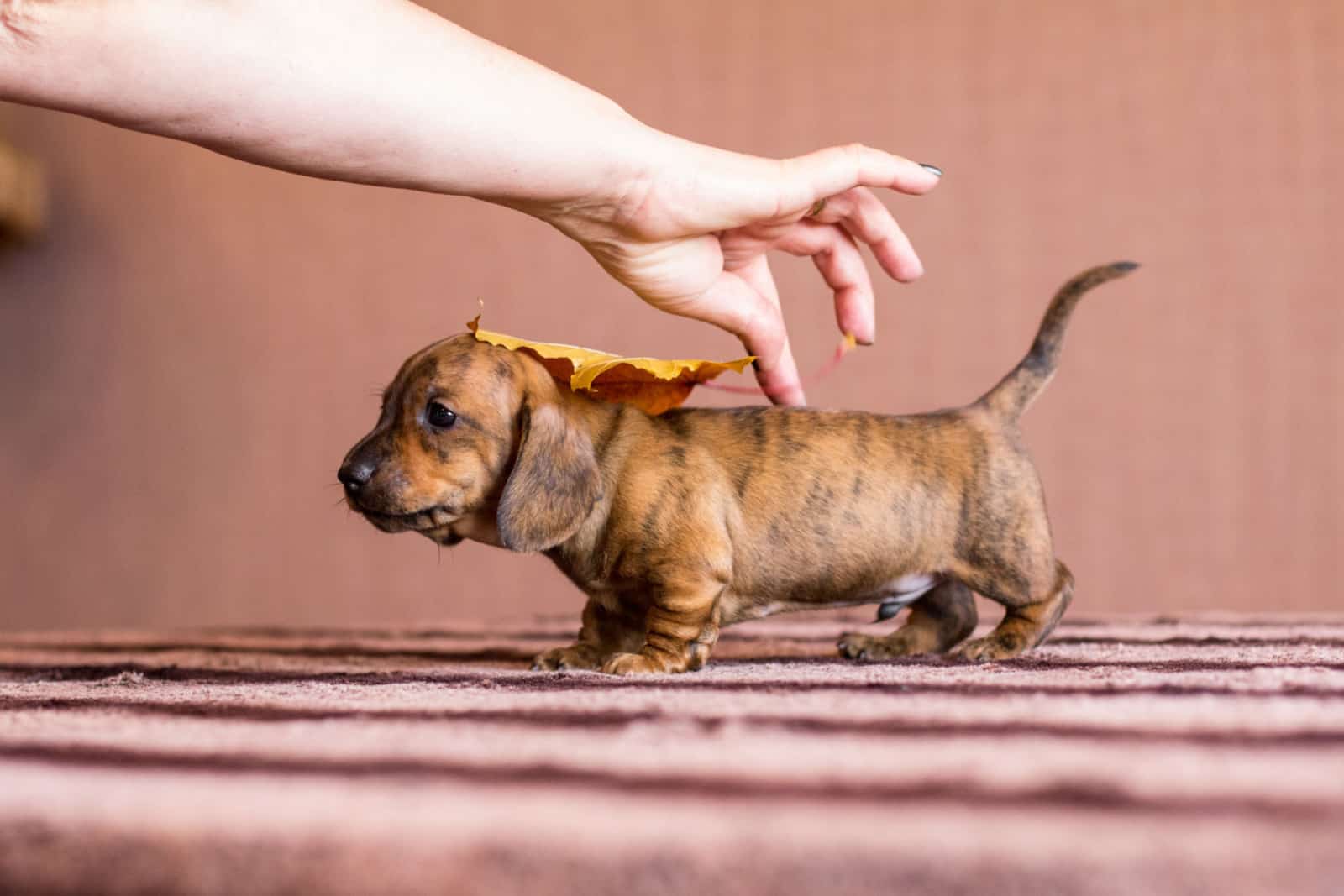
There are three different brindle Dachshund coat types that can form.
The first one is the standard, short haired smooth one that makes the dog look like he has been thoroughly polished and the brindle only adds to that effect.
It’s the one that sheds the least and makes grooming a breeze.
Then you have the next one in line, the long haired brindle option which has longer hairs and makes your dog look like he has a case of bedhead, but isn’t all that bad as it makes him fluffier and better to cuddle with.
The grooming aspects of it are certainly more tedious, but it’s nothing too bad given the dog’s size.
Finally, there’s the brindle wire haired Dachshund option which is the most unruly of all three types.
It feels pretty rough and makes the Doxie look older than he is. It provides him with more protection, but it comes at the cost of you having to take up your dog brush more often to keep the coat groomed and to keep the hair from your furniture.
Not always, there’s something called a reverse Brindle Doxie as well, one that has the base be a darker color while the usual striping from the brindle gene appears lighter.
It’s a neat, albeit incredibly rare mutation, so good luck finding one for sale that doesn’t have an exorbitant price tag tacked onto it.
The Dachshund is considered to be a small dog breed, bordering on the bare minimum of medium breeds in some cases.
Their size comes in 2 standard categories, each of which are divided by their weight.
The average weight for the standard Dachshund is anywhere between 16 to 32 pounds, give or take a few, and are around 8 to 9 inches tall, as they’re more long than they are tall.
Doxies who fall below the 11 pound line, getting into single digit numbers down to 8 pounds, are called miniature Dachshunds and they’re often around 5 to 6 inches tall.
They’re arguably the more popular of the two, but both types see a relatively similar amount of love.
The standard life expectancy of a Dachshund comes in at around 12 to 16 years. They’re a relatively healthy breed and do enjoy a long life, one of their few detriments is their shape, but that too can be a minor issue if proper exercise and dieting is followed.
While the Dachshund is a healthy dog in general, there are a few health problems one needs to be wary of when raising this breed.
A lot of them can be serious if left untreated, others simply boil down to minor annoyances.
They’re mostly rare too, but it’s worth being informed about them so you know what to be on the lookout for when you have a Doxie in the house as it may just save your doggo’s life.
Here are some of the most common health issues for Dachshunds:
Bloat
One of the most common problems in dogs and one of the more debilitating ones too.
It’s a condition where, after the stomach distends to accommodate large quantities of food, fluid or gas, it tries to retract back into its original form but ends up tangling around itself, causing an intestinal blockage of the stomach’s contents.
It also cuts off the flow of blood to a number of vital organs depending on the severity, the consequences of which are going to show up almost instantly.
The situation will visibly be getting worse on the outside too with sudden lethargy and weakness being the most apparent symptoms on the dog and a bloated appearance of the abdominal area.
If you notice any of these signs, get your dog over to a vet immediately so he can remedy the condition and hopefully save your canine companion from any potentially permanent damage.
The cause usually ends up being overeating or the dog not knowing how to pace himself while eating.
While the occurrence of the problem can’t be fully prevented, you can minimize it by teaching your dog proper pacing during meals early or you can break his daily food intake down into more, smaller portions to artificially pace him.
Obesity
Another issue that affects a lot of dogs with smaller dogs being more at risk from it directly given how a gain of a few pounds has a bigger impact on them than on large dog breeds.
The risks are the same as they would be in humans, lethargy, lack of energy, increased risk of heart disease and the like, though it also poses the risk of various bone related issues like patellar luxation or elbow and hip dysplasia due to the added pressure.
It’s one of the easiest issues to avoid, but also one of the easiest ones to fall into if you end up
neglecting it for a brief period of time.
The key to prevention is a healthy diet and plenty of daily exercise to meet both the dog’s daily nutritional needs and exercise requirements.
Try to avoid feeding your pupper lots of empty calories with no nutritional value as then his health will deteriorate in other ways instead.
If you’re having trouble getting him adjusted to a healthier lifestyle, then I advise consulting with a veterinarian or a certified pet nutritionist for advice on how to adapt his current diet to be healthier and less likely to be rejected by the dog.
Hip And Elbow Dysplasia
An issue common in many dogs, mostly larger ones, but smaller pups can suffer from it too, especially if they end up packing a few pounds extra.
The name already gives it away as being a condition where the hip or elbow joint falls out of place either due to wear or genetic reasons.
Whatever the case may be, it’s not something that can be fixed and is likely to be an issue for the remainder of your furry friend’s life.
However, there are steps that you can take to help prevent the issue by feeding your dog food with glucosamine and chondroitin in it to maintain proper bone and joint health and keeping him at a healthy weight.
The condition isn’t hard to notice either as your dog will be showing clear signs of discomfort or will
be limping and the affected limb can potentially look abnormal, depending on the severity of the condition.
Patellar Luxation
Another bone related issue that can be genetic or a cause from being overweight, one where the kneecap itself shifts out of place which can be extremely painful for your Dachshund.
Thankfully, this one can be treated via surgical procedure and medication to help reduce the pain.
The prevention methods are the same as they would be in hip and elbow dysplasia, obesity prevention and good amounts of exercise.
Should your dog end up suffering from a luxating patella though, rest can help aid in recovery too, so you’ll have to keep your Doxie put for the duration of the recovery period.
Cataracts
One thing a Dachshund is genetically predisposed to is suffering from cataracts, a condition where the affected eye ends up getting clouded and losing vision progressively, depending on the type of cataracts.
If not treated, your dog can end up blind in the affected eye, but, if it didn’t progress too far yet, the vet can surgically remove the cataracts from the eye and have your dog be back to his old self.
The surgical procedure is a pretty routine one too with a high success rate, though said success rate does drop somewhat depending on the stage of progression of the cataracts.
Progressive Retinal Atrophy
Better known under its acronym, PRA is best described as a gradual failing of the photoreceptor cells within the eye, the cone and rod cells to be more precise.
There’s no real cure for this, but there are treatments which can somewhat slow the progression of it down.
The end result is complete blindness with the dog’s night vision going first, followed by their full vision over time.
And the stage at which a dog can be affected by these is also relatively random. Some dogs can have it start from birth, while others only suffer from it when they’re well into their senior years.
Epilepsy
Another major issue that the Dachshund breed is unfortunately predisposed towards, one that affects the nerves themselves and causes seizures due to some sort of anomaly in brain function.
Normally triggered by bright, flashing lights and similar factors, the condition can be fatal if the dog is left unsupervised or he can end up sustaining major damage.
If your dog suffers from epileptic seizures, make sure he’s in a safe and comfortable space where he can’t hit his head against anything hard.
Thankfully, dogs don’t have a risk of swallowing their tongues during a seizure unlike humans.
There’s no known cure for this so far, so the best thing you can do for your canine companion is to make it as comfortable for him as you can.
Unfortunately, epilepsy is often a sign that there’s some other potential complications with the dog’s nerves, so his estimated lifespan will likely be a few years shorter.
Parasites
There’s nothing positive about parasites, especially worms which can plague your dog and cause a number of problems.
They drain the nutrients from the food that your doggo eats and take it for themselves, leaving him malnourished, acting lethargic, and, oftentimes, vomiting and showing rapid weight loss.
If caught during his puppy years and left unchecked, it can even lead to problems in development, be it physical or mental, which is a foundation for a whole mess of other issues.
This is why it’s recommended for all dog owners to take their dogs for routine worm check ups, even if they seem fine, just to be safe.
Usually every 2 months during their puppy period is recommended, but it’s better to take advice from your local vet than from guesses online.
Intervertebral Disc Disease
Also known as IVDD, this condition can be a very uncomfortable experience for your precious pooch.
It’s a condition that mainly affects longer dog breeds, especially ones with short legs like Dachshund dogs and similar, given how their center of gravity is in a pretty bad position that keeps applying pressure to a few vertebrae on the spine.
That’s why the likelihood for this disease occurring rises higher the further along his life the Dachshund gets.
It forms itself as a hernia between the discs and then applies further pressure to the rest of the spinal column which can cause some serious damage if left untreated.
Though while it does sound extremely serious, it is curable through plenty of rest, medication, and prescribed exercise routines.
Your dog will need to stay put during this as moving around too much will only worsen the condition.
In more serious cases, there may be need for surgery, but even that’s routine, though one shouldn’t wait too long after the vet recommends it as the condition may end up causing permanent nerve damage otherwise.
This little weenie dog sure does. While not the heaviest shedder, all dachshunds, including the brindle one, tend to shed a decent amount.
That’s why you may be required to groom him with a good brushing session every week or so to help keep the fur out of your house. During periods of heavy shedding, it may be even less than a week per grooming session, so make sure you’re prepared.
I’d say that solely depends on you, but the breed is affordable and this cute little doggy comes as a pretty good package for the price.
The Pros
He’s intelligent, loyal and protective of his family, making him a great family dog.
He can work in smaller spaces as he doesn’t need a lot of room to reside in, but does need larger spaces to run around in from time to time, like a garden or a nearby park, just to get his energy reserves spent so he can be calm around the house.
He’s relatively easy to train and doesn’t require too much socialization training to get along well with other pets and children.
The dog has a relatively low maintenance cost with only needing a mere half hour of moderate exercise a day and not eating a whole lot.
He also lives for a relatively long time while remaining healthy throughout his lifespan barring the rare case of one of the issues mentioned above, most of which are avoidable.
The Cons
That said, the Dachshund isn’t without his shortcomings either.
Given his high prey drive paired with his intelligence, he may end up being real stubborn at times and may need a little bit of discipline to get him back in line.
His intelligence and loyalty also leave him prone to heavy bouts of separation anxiety if your family tends to be away for a good portion of the day.
This can then lead to the destruction of footwear or furniture as a cry for attention.
His loving nature is a double-edged sword too as that means he won’t be the best watchdog if he tries being sociable with every person that he meets.
There’s plenty of good here with a little bit of bad that can be ironed out.
I’d say that the Dachshund is a great dog for first time pet parents, but also offers something unique for the experienced dog owner too.
In Conclusion
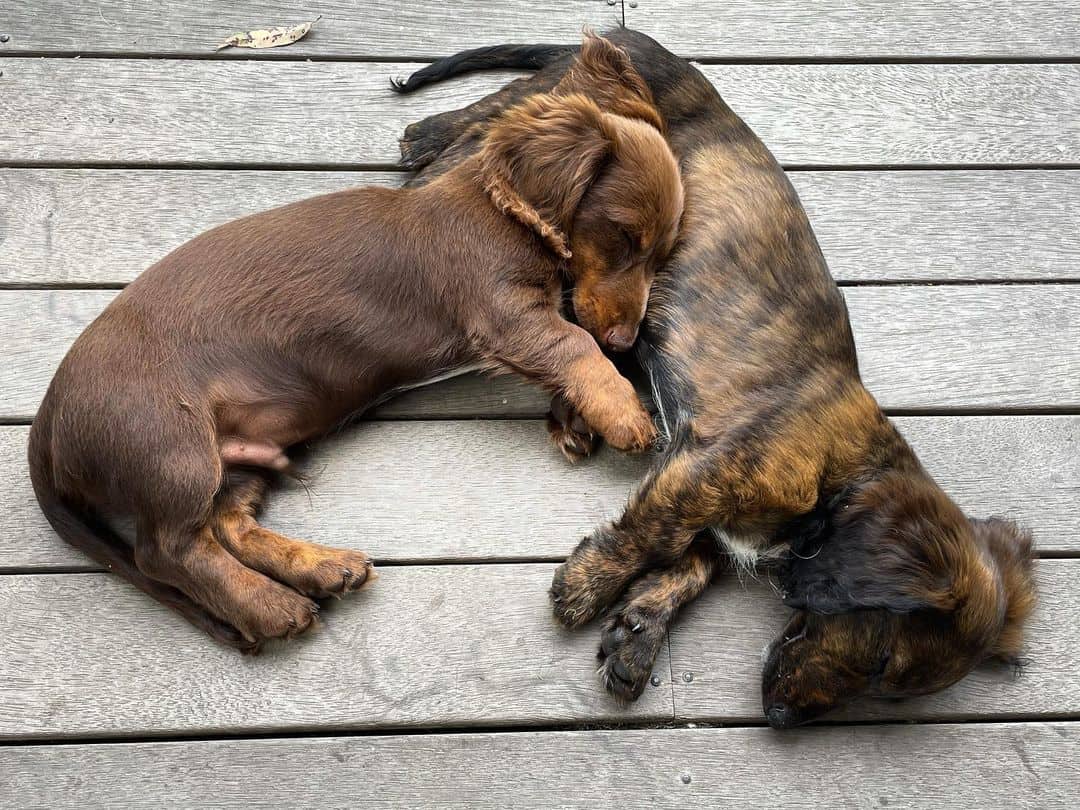
The brindle Dachshund is a unique take on the iconic wiener dog, one that takes existing coat color patterns and adds a little bit of extra shading to them, so to speak, making the dogs look more animated when they walk around.
The brindle pattern doesn’t affect the dog negatively in a genetic sense, at least nothing has been discovered thus far, and, depending on the color, can end up costing less than some specific show dog options would.
There’s no extra maintenance involved and the dog is going to be as lovely as ever, with all his strengths and weaknesses.
Hopefully, this article has shown you just how great of an addition one of these can be for your home and that you’ll soon be enjoying the company of one of the world’s most sociable dogs. Until next time, pet parents.
RELATED LINKS:
